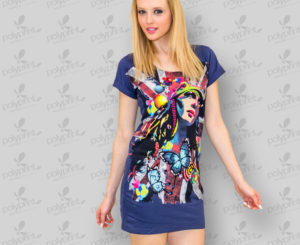
Direct to garment printing on to dark shirts has been a challenge over the years, mainly because the operators have been missing one or more of the important processes. Amaya Sales UK’s MD, Peter Wright, explains further.
If you visit trade shows, I’m sure you will have noticed the difference in quality in the samples that the suppliers give you. I find it hard to believe that a supplier of a product would give you an inferior print sample when they are trying to sell their products, but it does happen. Maybe the perceived value of quality is different from one supplier to the next.
So, how do you give yourself the best possible chance of creating the perfect DTG print?
Use the best art file possible
The best type of file is a vector format because it can be sized up or down without reducing the quality. So ask your customer if they can supply a PNG, PSD or EPS file. If they can only supply a JPG file, ask to send in the size they want printed and at 300dpi. The issue with a JPG type file is that it limits your ability to manipulate it. Ideally the PNG file is best because it already as a transparent background. You can them automatically cut out the background on your DTG rip software.
Use the best possible garment
The most suitable garment for DTG printing is made of 100% ring spun cotton. The DTG water-based inks are made specifically for printing on to cotton fabrics. Tightly woven fabrics will give a crisper more accurate finish than a loose weave such as a polo type.
Ask you equipment supplier for their suggestions on the best garment to use. You can DTG print on to most quality shirts but to achieve the premium quality the ring spun ones are much better.
You can also print on to blended fabrics and recommendations are up to 50/50% polyester but the image will never be as bright as on 100% cotton.
Pre-treating
Consistent pre-treating is the secret to a perfect quality print. Operators often blame other factors but a good pre-coat applied evenly will normally solve most quality issues.
You need to apply the optimum amount to the garment for best results. If you apply too little, the design will look weak or patchy. If you apply to much the design may look fine but there is a chance that the ink will wash off. This is because the ink is laying on the pre-coat and not into the fabric. Achieving the best results requires a little practice so please try different garments and spray levels until you are satisfied.
You could of course purchase an automatic pre-treater. On the better ones you will have two or four spray nozzles to give uniform spraying and you can also control the amount of liquid laid down. These type of machines take away all the guess work.
Remember, once you get pre-treating correct your designs will improve dramatically.
White ink control
Most DTG printers have their own RIP software that allows you to control ink flow amounts, size and positioning. Normally you do not need the maximum white ink to be laid down to produce the best quality print. Experiment with lowering the white ink amount by say 10 or 20% and I think will not see the difference. You can get to a point where too much white ink can affect the quality. Just remember that a good white layer will really enhance the top CMYK colours and give you a crisp and vibrant finish.
Finishing off the printed garment
When you have printed your garment you will have to dry the ink on a heat press. Make sure you have a good quality press and preferably one that hovers.
Sometimes your garment will come off the printer looking perfect but after heat pressing it becomes dull. This often depends on the amount of ink you put down. One way to combat this is to place the garment on the press and hover the top plate over the garment for about a minute and then use a not to heavy pressure to finally cure it.
Keep these tips in mind and you should be able to print perfect DTG prints on to black or dark garments.
 Printwear & Promotion The Total Promotional Package
Printwear & Promotion The Total Promotional Package




